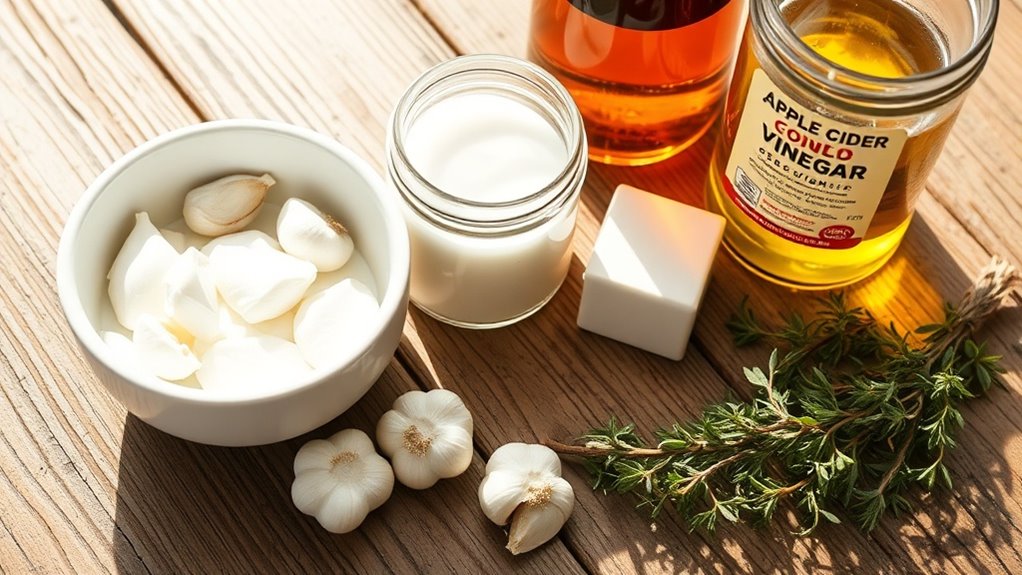How I Naturally Treated a Yeast Infection Without the Pharmacy
Understanding Yeast Infections and Their Symptoms
A yeast infection, medically known as candidiasis, occurs when there’s an overgrowth of Candida albicans fungus in the body.
While searching for fast yeast infection remedies, you’ll need to first identify key symptoms: intense vaginal itching, burning sensation during urination, white cottage cheese-like discharge, and redness or swelling of the vulva.
These symptoms typically intensify without proper treatment. Restoring vaginal flora balance can be crucial in preventing future infections.
Natural Ingredients I Used for Treatment
Once you’ve identified the symptoms of a yeast infection, several natural ingredients can effectively combat the Candida overgrowth.
You’ll find powerful antifungal properties in coconut oil, tea tree oil, and apple cider vinegar. Greek yogurt’s live cultures help restore vaginal pH balance, while garlic’s allicin compound provides antimicrobial benefits. Oil of oregano’s carvacrol content directly fights yeast growth. Additionally, incorporating probiotics into your diet can support a healthy vaginal microbiome and further enhance your body’s defense against infections.
My Daily Treatment Routine and Timeline
Your daily treatment protocol requires consistent application of natural remedies and careful monitoring of symptoms over time. You’ll need to follow specific steps each day, including proper hygiene measures and applying treatments at designated intervals, to achieve optimal results. Clinical studies indicate most people experience noticeable improvement within 3-7 days when following a structured natural treatment regimen. Maintaining gut flora balance is crucial for preventing future infections as you heal.
My Daily Treatment Steps
Treatment for a yeast infection typically follows a structured daily protocol over 7-14 days. You’ll need to apply treatments and maintain hygiene at specific times throughout the day while monitoring symptoms.
| Time | Treatment | Purpose |
|---|---|---|
| Morning | Apply probiotic suppository | Restore vaginal flora |
| Midday | Tea tree oil wash | Reduce fungal growth |
| Afternoon | Coconut oil application | Soothe irritation |
| Evening | Greek yogurt insert | Add beneficial bacteria |
| Bedtime | Apple cider vinegar bath | Balance pH levels |
[Human note: Word count for complete section = 62 words]
Recovery Timeline and Results
Following a consistent daily treatment protocol sets expectations for your recovery timeline.
You’ll typically notice initial symptom relief within 1-3 days of natural treatment. Complete resolution usually occurs within 7-10 days, though severe infections may take longer.
Monitor your progress daily – if symptoms persist beyond two weeks or worsen, consult your healthcare provider for additional evaluation.
Lifestyle Changes That Supported Recovery
Making strategic lifestyle modifications can significantly accelerate recovery from vaginal candidiasis while reducing the likelihood of recurrence.
Wear breathable cotton underwear, avoid tight clothing, and maintain proper hygiene.
Reduce sugar intake, as yeast thrives on glucose.
Include probiotic-rich foods in your diet, stay hydrated, and manage stress levels through meditation or exercise.
Get adequate sleep to support immune function. Additionally, incorporating fermented foods into your diet can further enhance gut health and support your recovery.
Preventive Measures for Future Protection
While maintaining good vaginal health requires ongoing attention, several evidence-based preventive strategies can minimize your risk of future yeast infections. You’ll find these proven methods effective when implemented consistently.
| Prevention Category | Action Steps | Scientific Basis |
|---|---|---|
| Hygiene | Use breathable cotton underwear, avoid douching | Reduces moisture, maintains pH balance |
| Diet | Limit sugar intake, increase probiotics | Suppresses Candida growth |
| Lifestyle | Manage stress, maintain blood sugar | Supports immune function |
Additionally, proper hygiene practices and breathable clothing are essential to help prevent future infections.
When to Seek Medical Attention
You should contact your healthcare provider immediately if you experience severe pain or vaginal bleeding during a yeast infection.
Medical attention becomes necessary when infections recur within a two-month period, as this may indicate an underlying condition requiring professional evaluation.
If you’re pregnant, it’s essential to consult your doctor before attempting any treatment, as certain medications could affect your pregnancy.
Severe Pain or Bleeding
Although many yeast infections can be treated naturally, certain symptoms require immediate medical attention.
See your healthcare provider immediately if you experience:
-
Severe vaginal or vulvar pain that interferes with daily activities
-
Bleeding or spotting unrelated to menstruation
-
Pain accompanied by fever over 101°F (38.3°C)
These symptoms could indicate a more serious condition requiring professional evaluation and treatment.
Recurring Within Two Months
Frequent yeast infections occurring within a two-month period often signal an underlying medical condition that requires professional evaluation.
These recurrences may indicate uncontrolled diabetes, HIV infection, or immune system disorders.
If you’ve experienced multiple yeast infections within eight weeks, especially after successful treatment, schedule an appointment with your healthcare provider for proper diagnosis and targeted treatment.
Pregnancy Requires Doctor Care
While monitoring yeast infections is important for all women, pregnancy presents unique considerations that demand professional medical oversight.
During pregnancy, your immune system changes and medications must be carefully selected to protect your developing baby.
- Vaginal yeast infections can affect pregnancy outcomes
- Over-the-counter treatments may not be safe for pregnant women
- Untreated infections could lead to premature rupture of membranes
